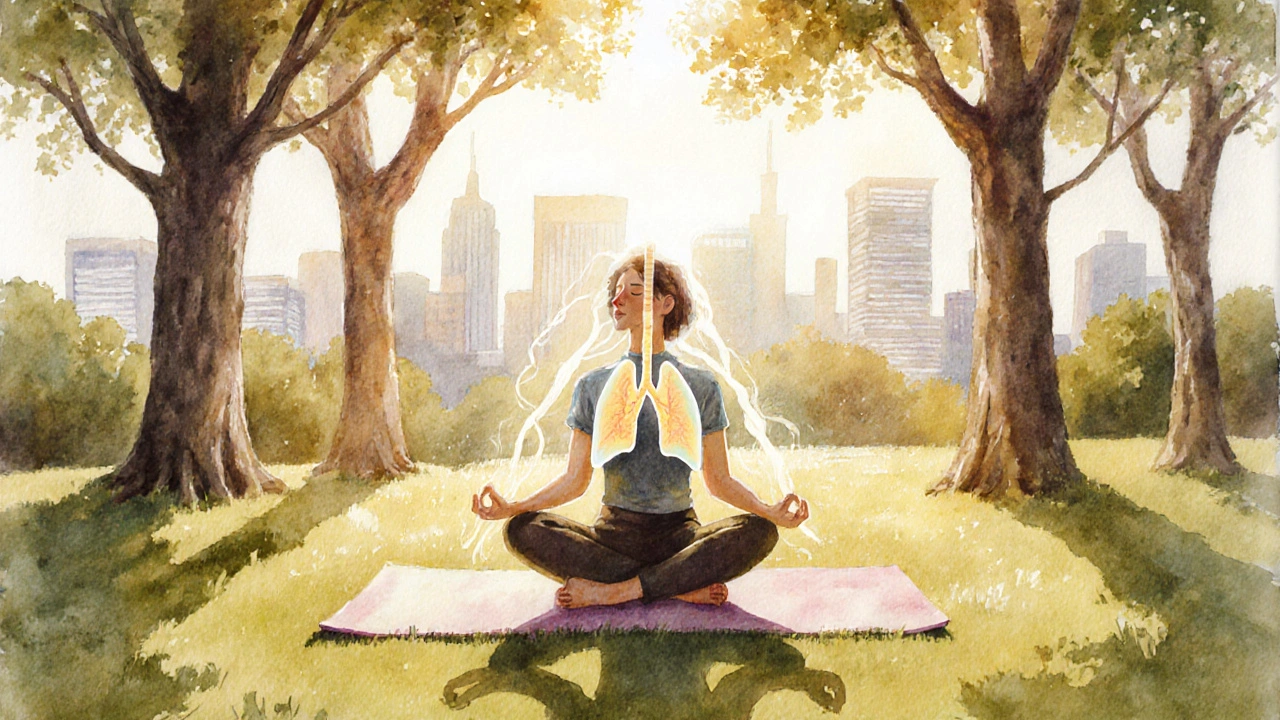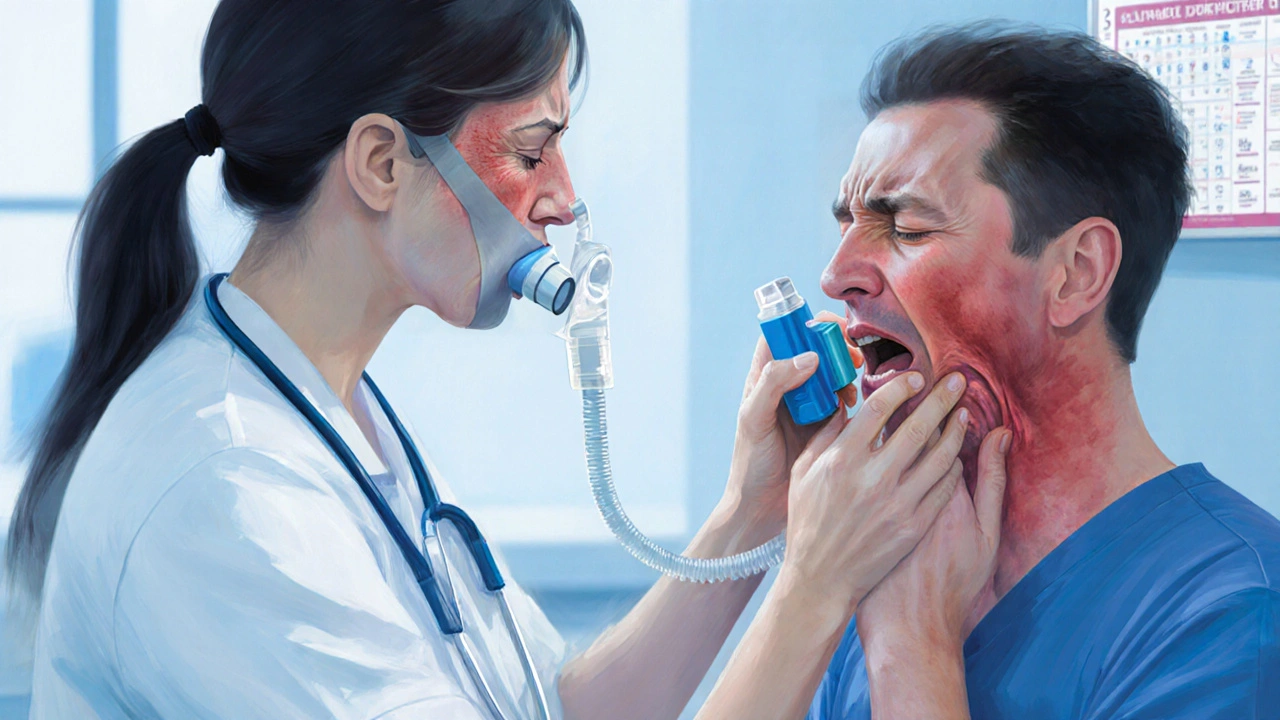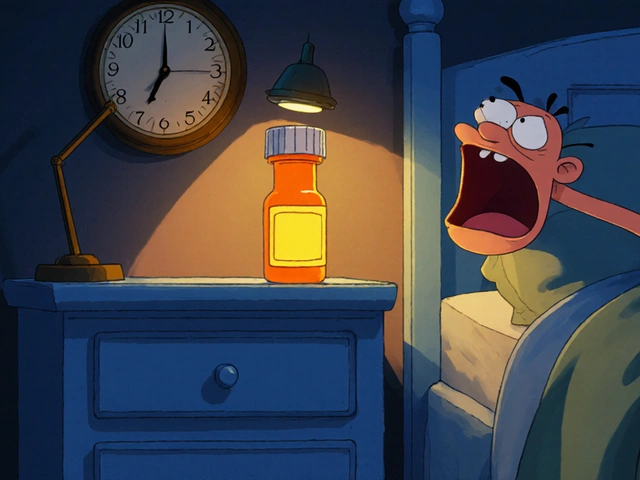Bronchospasm is a sudden tightening of the airway muscles that restricts airflow and causes wheezing, cough or a feeling of chest tightness. It is most often linked to asthma, but growing research shows a clear connection between bronchospasm and anxiety. Understanding that link can change how you manage breathlessness, especially when panic shows up out of the blue.
What is Anxiety and How Does It Affect Breathing?
Anxiety is a psychological state characterised by excessive worry, tension and physical arousal. When anxiety spikes, the body activates the autonomic nervous system, releasing stress hormones like cortisol and adrenaline. These chemicals speed up heart rate, raise blood pressure and, crucially for our lungs, stimulate the sympathetic nervous system. The result? Faster, shallower breaths that can turn into hyper‑ventilation.
Physiological Bridge: From Stress to Bronchospasm
Three key pathways link anxiety to airway constriction:
- Hyper‑ventilation - Rapid breathing lowers carbon‑dioxide levels, causing the airway smooth muscle to contract.
- Vagal tone reduction - Anxiety suppresses the vagus nerve, which normally helps keep the bronchi relaxed.
- Inflammatory mediators - Stress hormones can increase histamine release, a known trigger for bronchial spasms.
These mechanisms are the same ones that flare up asthma attacks, which explains why people with a history of asthma often notice anxiety‑induced breathlessness.
Bronchospasm vs. Asthma: Spot the Difference
| Trigger | Physiological Pathway | Typical Symptoms | Management Approach |
|---|---|---|---|
| Anxiety | Sympathetic activation & hyper‑ventilation | Sudden tightness, wheeze, feeling of “air hunger” | Breath‑control techniques, CBT, short‑acting bronchodilator |
| Allergen exposure | IgE‑mediated inflammation | Chronic cough, mucus, nocturnal wheeze | Inhaled corticosteroids, avoidance, long‑acting bronchodilator |
| Cold air | Reflex airway narrowing via vagus nerve | Sharp chest constriction, coughing | Warm humidified air, pre‑exercise inhaler |
Recognising a Panic‑Induced Bronchospasm
When anxiety turns into a panic attack, the line between a psychological episode and a genuine respiratory emergency blurs. Here are three red‑flags that suggest the breathlessness is anxiety‑driven rather than a pure asthma flare:
- Symptoms peak within minutes of a stressful thought or situation.
- There is a noticeable sense of dread, racing thoughts, or trembling.
- Standard asthma rescue inhaler brings only partial relief.
If you spot these signs, treating the anxiety component can break the vicious cycle.

Practical Tools: Breathing Techniques That Calm the Airways
Below are three evidence‑based breathing exercises that directly counter the physiological triggers of bronchospasm:
- Box breathing - Inhale for 4 seconds, hold for 4, exhale for 4, hold for 4. Repeating this pattern restores CO₂ balance and reduces sympathetic surge.
- Diaphragmatic breathing - Place a hand on the abdomen, breathe slowly through the nose, letting the belly rise. This activates the vagus nerve, promoting bronchial relaxation.
- 4‑7‑8 technique - Inhale for 4, hold for 7, exhale for 8 seconds. The prolonged exhale forces a gentle stretch of airway muscles, easing spasm.
Practising these tools twice a day builds a mental‑physical habit that blunts future anxiety spikes.
When to Reach for Medication
Even with optimal breathing strategies, acute bronchospasm may still require a quick‑acting bronchodilator. Inhaled bronchodilator is a short‑acting medication that relaxes airway smooth muscle within minutes. However, couples of points matter:
- Use it as soon as you feel the chest tighten, not after the panic has fully set in.
- Combine it with a calming technique to address both the physical and mental aspects.
- If you need it more than twice a week, consult a clinician-there may be an underlying respiratory condition.
Therapeutic Support: From CBT to Psychotherapy
Long‑term anxiety control often requires professional help. Cognitive‑behavioural therapy (CBT) is a structured psychotherapy that teaches patients to re‑frame anxious thoughts and develop coping skills. Studies show CBT reduces the frequency of panic‑related bronchospasm by up to 45%.
Other modalities, such as mindfulness‑based stress reduction (MBSR) and acceptance‑commitment therapy (ACT), also target the breath‑anxiety feedback loop. Pairing these therapies with regular breath work creates a robust defence against future episodes.
Putting It All Together: A Personal Action Plan
Here’s a step‑by‑step checklist you can keep on your phone or fridge:
- Identify early warning signs (rapid heartbeat, racing thoughts).
- Pause and start a 4‑7‑8 breathing cycle.
- If tightness persists after two breaths, grab your inhaled bronchodilator.
- Log the episode - note triggers, duration, and what helped.
- Schedule a weekly CBT or mindfulness session to work on underlying anxiety patterns.
Following this routine reduces the chance that anxiety will hijack your airways.

Frequently Asked Questions
Can anxiety cause permanent damage to my lungs?
Occasional anxiety‑induced bronchospasm doesn’t scar the lungs, but repeated episodes can increase airway sensitivity. Managing stress and using proper breathing techniques prevents chronic irritation.
Should I rely on my rescue inhaler for anxiety attacks?
A rescue inhaler is fine for immediate relief, but it won’t treat the anxiety root. Pair it with a quick breathing exercise or a grounding technique for lasting calm.
Is there a test to prove anxiety caused my bronchospasm?
Doctors can perform spirometry during a calm state and then during a stress test. A marked drop in airflow only when you’re anxious points to a psychogenic component.
Do breath‑control apps help?
Yes. Apps that guide box breathing or 4‑7‑8 cycles provide visual timing, which is especially useful during a panic surge when you can’t count yourself.
Can medication for anxiety reduce bronchospasm episodes?
Selective serotonin reuptake inhibitors (SSRIs) and benzodiazepines lower overall anxiety levels, which in turn reduces the frequency of anxiety‑triggered bronchospasm. They should be prescribed by a GP after a full assessment.






Matt Stone
Anxiety spikes and your airways slam shut; that’s the body’s fight‑or‑flight overreacting.
Joy Luca
The autonomic dysregulation you described-sympathetic surge, hypocapnia‑induced smooth‑muscle contractility, vagal tone attenuation-is essentially a neuro‑respiratory feedback loop. By integrating diaphragmatic breathing, you’re modulating the baroreflex and attenuating catecholamine‑driven bronchoconstriction. It’s crucial to pair these physiologic maneuvers with cognitive restructuring to prevent central sensitization. Moreover, short‑acting β2‑agonists act synergistically when administered pre‑emptively during an anxiety surge. Keep tracking your spirometry trends; the data will substantiate the psychophysiologic correlation.
Jessica Martins
The article correctly outlines the three primary pathways linking anxiety to bronchospasm. Hyper‑ventilation reduces PaCO₂, which triggers smooth‑muscle constriction. Reduced vagal tone removes a bronchodilatory influence, and stress hormones can elevate histamine release. Understanding these mechanisms helps clinicians differentiate panic‑induced bronchospasm from pure asthma exacerbations.
Ada Lusardi
Whoa, that feeling of “air hunger” is sooo scary 😱 but the box‑breathing trick can really calm it down 😊 just remember to count slowly and let the exhale be longer than the inhale 🌬️
Pam Mickelson
Hey folks, great rundown! If you practice diaphragmatic breathing every morning, you’ll notice your chest feels way less tight when stress hits. Stick with it, and pair it with a quick walk – the combo works wonders.
Joe V
Ah, the classic “panic attack masquerading as an asthma attack” scenario – how novel. One might suggest simply inhaling until the lungs collapse, yet the advisable course is to administer a bronchodilator whilst simultaneously engaging in a cognitive exercise. Your breath‑control regimen appears commendably thorough, if unsurprisingly predictable.
Scott Davis
Cool guide. The 4‑7‑8 method is easy to remember and actually helps keep the airway relaxed.
Calvin Smith
Wow, who would have thought that “thinking too hard” could make your lungs act like a busted accordion? Guess the universe loves a good drama, but your box‑breathing is the backstage pass that tells the show to chill the heck out.
Brenda Hampton
It’s fascinating how the brain’s perception of threat can hijack the bronchial smooth muscle. By training the prefrontal cortex through mindfulness, you essentially rewire the threat‑response circuitry, reducing the frequency of spasm triggers.
Lara A.
Everyone knows the pharma companies don’t want you to learn these simple breathing tricks!!! They want you hooked on inhalers, on steroids… they profit from your panic, from your fear, from your breathlessness!!!
Ashishkumar Jain
Bro, i think u should try the 4‑7‑8 technique before reaching for the inhaler. It really helps calm the mind and the chest. Stay chill!
Gayatri Potdar
Yo, they’re hiding the real cure in plain sight – breath control! The mainstream medics push pills, but the ancient yogis knew the secret all along… wake up!
Marcella Kennedy
Reading this piece reminded me of how often I’ve watched friends wrestle with that terrifying sensation of not being able to get enough air during a panic episode, and how helpless we all felt in those moments. The link between anxiety and bronchospasm is not just a medical curiosity; it’s a lived reality for many who juggle both conditions daily. When the sympathetic nervous system kicks into overdrive, the body’s natural response is to prepare for flight, and the lungs become a casualty of that misdirected urgency. I’ve seen patients who, after learning diaphragmatic breathing, report a noticeable reduction in the intensity of their attacks. It’s as if the simple act of placing a hand on the abdomen and guiding the breath back to the diaphragm signals the brain that safety has returned. Moreover, the psychological reassurance that comes from having a concrete tool cannot be understated. Knowing you have a “breathing toolbox” often reduces the anticipatory anxiety that fuels the whole cycle. The concept of pairing a rescue inhaler with a quick grounding technique is brilliant because it acknowledges both the physiological and psychological components. In my experience, the act of counting during the 4‑7‑8 exercise also provides a cognitive distraction, pulling attention away from catastrophizing thoughts. It’s also worth mentioning that regular practice of these techniques can enhance vagal tone over time, which is beneficial beyond just acute episodes. The article’s checklist is a practical roadmap; I would add a line about logging not only triggers but also emotional states, as emotions often precede the physical symptoms. Consistent journaling can reveal patterns that are otherwise invisible, empowering individuals to intervene earlier. If you’re skeptical about the efficacy of breath work, consider that numerous studies have demonstrated its impact on heart rate variability, a proxy for autonomic balance. Finally, remember that seeking professional help, whether through CBT or mindfulness‑based therapy, adds a layer of support that self‑help alone may not provide. You deserve to breathe freely, and combining these strategies offers a comprehensive path toward that goal.
Jamie Hogan
While your anecdotal reflections are heartfelt they lack the rigor of controlled trials.
Ram Dwivedi
Great points, Joy! For clinicians wanting to implement these techniques, I recommend starting patients with a 5‑minute guided box‑breathing session each morning – it builds neural pathways that make the response automatic during stress 😌👍 Additionally, integrating biofeedback can provide real‑time CO₂ monitoring, ensuring the patient stays within optimal ranges.